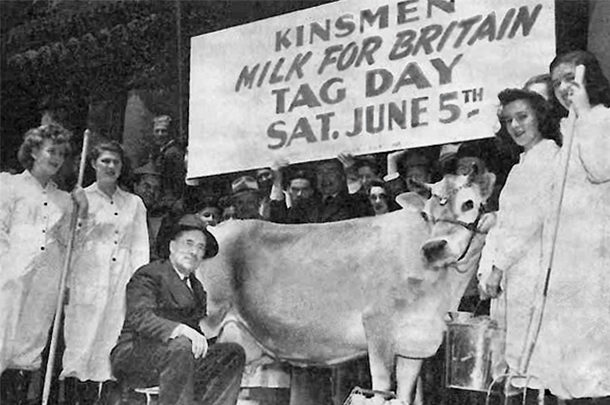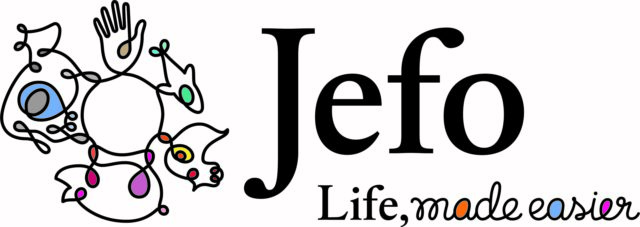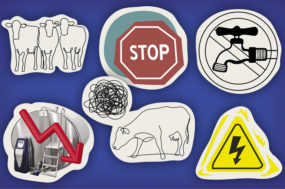Since milk and the farmers that produced it were vital to the campaign, Progressive Dairyman Editor Karen Lee interviewed Nadyne Esson, marketing coordinator, and Sarah Welton, communications and media assistant, with Kin Canada to learn more about the campaign and the video that will document it for years to come.
Describe the Milk for Britain campaign.
WELTON: It was Kin Canada’s first national project, and it lasted from 1941 to the years following World War II. It was in 1948 that it ended.
Kin and Canadians across the country raised more than $3 million together – or the equivalent to more than $42 million today – and they sent more than 50 million quarts of milk to Britain in powdered form in containers so they could add water to turn it back into liquid milk for whatever they needed.
It was because of the German air raids and supply line obstruction that was happening overseas in Britain at the time. Hitler actually expressed the fact that he wanted to try and starve Britain into submission.
Once Kin Canada’s founder, Harold (Hal) Rogers, found out about the need, he decided that he was going to step in and organize Kin Clubs to start sending milk overseas.
We believe the project is a really big deal as it helped shape Kin into the organization it is today. It started the female auxiliary group, our Kinette Clubs, and it spurred a massive expansion and growth of clubs across Canada.
How was the milk acquired?
WELTON: It was specifically purchased with monetary donations from what we know. Because of the strict rations going on since it was during wartime, Kin Canada did need to go through the government to purchase the milk and get the permission to send it overseas.
There was a little bit of a snafu partway through the campaign where they had to stop sending whole milk because they needed to send the whole milk to the soldiers.
Some farmers did donate cows used in the campaign. They had one particular cow they sent across Canada for some different events to help fundraise for the campaign.
Why is it important to share this piece of Canadian history?
WELTON: We think this is an important piece of how Canada really got involved after the Second World War with global humanitarian aid. This is pretty much the start, as far as we know, of Kin Canada really getting involved in the worldwide community by organizing this project and sending the huge amount of aid we did.
We had clubs all the way out in Vancouver and then clubs all the way on the East Coast in Newfoundland that were contributing, and yet we still managed to get everyone organized and working towards this common goal.
I think that speaks a lot to how Canada has gotten involved today. We help out within our borders, and we also send so much humanitarian aid to countries outside our borders now. This is just a huge part of that history and what it means to be Canadian today.
How did the documentary come about?
ESSON: This documentary was solely funded by our members. Our organization is funded by our members; they pay dues. We are not supported by the government at all. We did fundraising to pay for the documentary.
WELTON: They raised more than $53,000 in order to fund the making of the documentary.
ESSON: It is being made by Learnography (formerly Curriculum Services Canada), so it’s been directly designed to go right into the school system and has a teaching guide with it. Teachers will be able to select it as of September and add it to their teaching plans.
The documentary is developed for grades 7-12 curriculum. Why are schools a target audience?
ESSON: We felt it was important to create awareness about the story, being a part of Canadian history, and we wanted younger Canadians learning about Kin Canada as they come up to the age of deciding about volunteering in their community.
It was kind of a double piece of Canadian history and also the importance of volunteering and what can be done by a determined group of people.
WELTON: Even just small efforts. We’ve got a lot of stories surrounding the campaign of individuals doing small things on their own that contributed a lot to the campaign.
What are some of those additional stories?
ESSON: The incredible leadership of our founder, Hal Rogers, whose spirit still leads members across Canada. He made a big promise, and then he committed to that promise and he made it happen. He rallied people and he made it happen.
WELTON: Another interesting thing to note is the small amount of people making a big difference. We had less than 3,000 members in the clubs across the country to help out when Milk for Britain first started.
We’re at almost 500 service clubs today, but it was significantly less than that when Milk for Britain first started. We had so many of the Kinsmen that were going off to war and helping out because they were all in that age range.
Kin got involved in every single aspect of the Second World War, from sending its members overseas, to helping out on the home front, to getting Milk for Britain organized.
ESSON: One of the important parts of the story that Hal Rogers’ daughter likes to stress is: because of the Canadian government not allowing them to send whole milk anymore, they had to take it down to skim milk. The skim milk wasn’t as palatable for the children, so the Kinsmen changed it and sent chocolate milk.
In addition to students, who else should view the documentary?
ESSON: This story is actually just fascinating for anyone to watch. Of course, it’s been designed to captivate audiences of a younger demographic, but anyone can appreciate the near-miraculous feats of people trying to just coordinate and communicate at that time to organize this type of project.
Also, on the other side when the milk got there, there were more than a million women that were organized who distributed the milk. It’s a great story about women triumphing and starting to step into the limelight.
There are a lot of incredible stories that stem out from the Milk for Britain story. I think anyone would find it interesting.
What do you hope audiences will take away from this film?
ESSON: We’re hoping that it will bring some awareness to volunteerism and the importance of giving back. That is really what our organization is about, and that’s what the project was about. That’s Kin. This was just the first of many, many projects historically.
WELTON: We put together thousands of services hours and millions of dollars every year. In the 2014-2015 year, we actually provided more than 500,000 service hours, and we raised more than $20.4 million.
We just want to show the fact that, even at a small level, you can make a difference in your community. We really strive for our motto at Kin, “Serving the Community’s Greatest Need,” no matter how big that need might be.
How can people view the documentary?
WELTON: We are making the documentary available on our YouTube channel for free for anybody to watch. ![]()
PHOTO: At a Milk for Britain Tag Day, one of the controllers from the local committee got up in front of City Hall in Toronto to milk a thoroughbred Jersey cow. Photo provided by Kin Canada.










